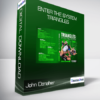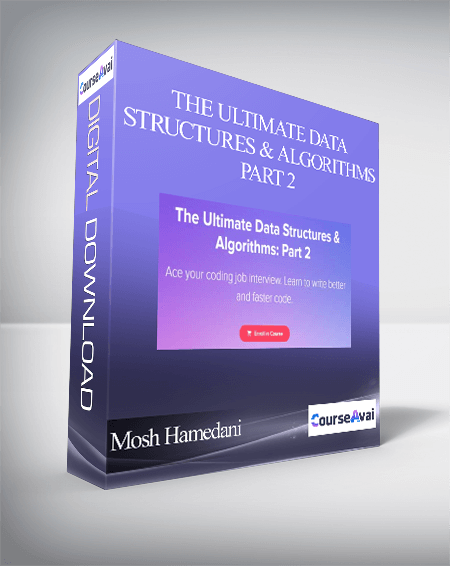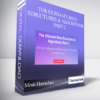$10.00 Original price was: $10.00.$5.00Current price is: $5.00.
Studied Computer Science – but never really understood the complex topic of data structures and algorithms?
Or maybe you’re a self-taught programmer, with little to no knowledge of this important topic.
Or perhaps you failed a job interview because you couldn’t answer basic data structure and algorithm questions.
 Purchase this course you will earn 5 Points worth of $0.50
Purchase this course you will earn 5 Points worth of $0.50Elevate your skills with the Mosh Hamedani – The Ultimate Data Structures & Algorithms: Part 2 course, available for just $10.00 Original price was: $10.00.$5.00Current price is: $5.00. on Utralist.com! Browse our curated selection of over 60,000 downloadable digital courses across diverse Everything Else. Benefit from expert-led, self-paced instruction and save over 80%. Start learning smarter today!
Studied Computer Science – but never really understood the complex topic of data structures and algorithms?
Or maybe you’re a self-taught programmer, with little to no knowledge of this important topic.
Or perhaps you failed a job interview because you couldn’t answer basic data structure and algorithm questions.
Purchase Mosh Hamedani – The Ultimate Data Structures & Algorithms: Part 2 courses at here with PRICE $10 $5
DOWNLOAD INSTANTLY
PLEASE CHECK ALL CONTENTS OF THE COURSE BELOW!
Mosh Hamedani – The Ultimate Data Structures & Algorithms: Part 2
Studied Computer Science – but never really understood the complex topic of data structures and algorithms?
Or maybe you’re a self-taught programmer, with little to no knowledge of this important topic.
Or perhaps you failed a job interview because you couldn’t answer basic data structure and algorithm questions.
So, why are data structures so important these days?
Data structures and algorithms are patterns for solving problems. Developers who know more about data structures and algorithms are better at solving problems. That’s why companies like Google, Microsoft and Amazon always include interview questions on data structures and algorithms. They want to assess your problem-solving skills. They don’t care how many programming languages and frameworks you’re familiar with.
A complex topic made simple
That’s why I made this course. I want to demystify data structures and algorithms once and for all.
I remember being hopelessly confused when my college lecturer tried to teach it, many moons ago. So I had to teach myself. Now I’m an expert on the topic, and I want to save you the dozens of hours I wasted at the library trying to wrap my head around it.
By the end of this course…
You’ll be able to:
- Ace your next coding interview
- Write better, faster code
- Become a better developer
- Improve your problem solving skills
- Master computer science fundamentals
- Implement all the essential data structures from scratch
- Master dozens of popular algorithms
What you’re going to learn
This course is the second of a series. In the first part, we covered the linear data structures (Arrays, Linked Lists, Stacks, Queues and Hash Tables). In this part, we’ll be focusing on non-linear data structures. Part 3 is about searching, sorting and string manipulation algorithms.
Here’s what you’re going to learn in this part:
- Binary Trees
- AVL Trees
- Heaps
- Tries
- Graphs
This is the most comprehensive data structures and algorithms series online. Every example and exercise is picked from popular interview questions asked by Google, Microsoft, Amazon and other big companies.
Who is this course for?
- Anyone preparing for a coding job interview
- Computer science students whose lecturers failed to explain the topics
- Self-taught developers who missed out on a computer science degree
- Anyone who wants to become a better developer
Course Curriculum
Getting Started
Start1- Introduction (0:50)
Start2- Source Code
Binary Trees (73m)
Preview1- Introduction (0:55)
Preview2- What are Trees (5:36)
Preview3- Exercise- Populating a Binary Search Tree
Preview4- Exercise- Building a Tree (2:41)
Preview5- Solution- insert() (7:44)
Preview6- Solution- find() (2:00)
Start7- Traversing Trees (5:58)
Start8- Exercise- Tree Traversal
Start9- Recursion (5:39)
Start10- Depth First Traversals (5:23)
Start11- Depth and Height of Nodes (7:06)
Start12- Minimum Value in a Tree (7:37)
Start13- Exercise- Equality Checking (0:45)
Start14- Solution- Equality Checking (4:08)
Start15- Exercise- Validating Binary Search Trees (4:14)
Start16- Solution- Validating Binary Search Trees (4:18)
Start17- Exercise- Nodes at K Distance (1:48)
Start18- Solution- Nodes at K Distance from the Root (4:37)
Start19- Level Order Traversal (2:55)
Start20- Trees- Exercises
Start21- Summary (1:22)
AVL Trees (49m)
Start1- Introduction (0:31)
Start2- Balanced and Unbalanced Trees (3:01)
Start3- Rotations (5:02)
Start4- AVL Trees (4:04)
Start5- Exercise: AVL Rotations
Start6- Exercise- Building an AVL Tree (1:11)
Start7- Solution- insert() (8:47)
Start8- Exercise- Height Calculation (1:24)
Start9- Solution- Height Calculation (2:43)
Start10- Exercise- Balance Factor (2:04)
Start11- Solution- Balance Factor (4:01)
Start12- Exercise- Detecting Rotations (2:54)
Start13- Solution- Detecting Rotations (3:32)
Start14- Exercise- Implementing Rotations (3:51)
Start15- Solution- Implementing Rotations (5:40)
Start16- AVL Trees- Exercises
Start17- Summary (1:01)
StartA Quick Note
Heaps (53m)
Start1- Introduction (0:21)
Start2- What are Heaps (6:28)
Start3- Exercise- Working with Heaps
Start4- Exercise- Building a Heap (1:55)
Start5- Solution- insert() (8:24)
Start6- Solution- remove() (7:07)
Start7- Solution – Edge Cases (6:11)
Start8- Heap Sort (2:29)
Start9- Priority Queues (5:04)
Start10- Exercise- Heapify (1:26)
Start11- Solution- Heapify (7:12)
Start12- Solution- Optimization (2:42)
Start13- Exercise- Kth Largest Item (0:31)
Start14- Solution- Kth Largest Item (3:47)
Start15- Heaps- Exercises
Start16- Summary (1:19)
Tries (46m)
Start1- Introduction (0:30)
Start2- What are Tries (3:50)
Start3- Exercise- Populating a Trie
Start4- Exercise- Building a Trie (3:03)
Start5- Solution- Building a Trie (5:44)
Start6- An Implementation with a HashTable (1:50)
Start7- A Better Abstraction (5:28)
Start8- Exercise- Looking Up a Word (1:12)
Start9- Solution- Looking Up a Word (2:35)
Start10- Traversals (3:35)
Start11- Exercise- Removing a Word (1:53)
Start12- Solution- Removing a Word (8:14)
Start13- Exercise- Auto Completion (2:51)
Start14- Solution- Auto Completion (5:59)
Start15- Tries- Exercises
Start16- Summary (0:45)
StartA Quick Note
Graphs (66m)
Start1- Introduction (0:26)
Start2- What are Graphs (2:09)
Start3- Adjacency Matrix (4:14)
Start4- Adjacency List (6:32)
Start5- Exercise- Building a Graph (1:50)
Start6- Solution- Adding Nodes and Edges (7:34)
Start7- Solution- Removing Nodes and Edges (4:48)
Start8- Traversal Algorithms (3:58)
Start9- Exercise- Traversal Algorithms
Start10- Exercise- Depth-first Traversal (Recursive) (1:29)
Start11- Solution- Depth-first Traversal (Recursive) (3:44)
Start12- Exercise- Depth-first Traversal (Iterative) (2:44)
Start13- Solution- Depth-first Traversal (Iterative) (3:59)
Start14- Exercise- Breadth-first Traversal (Iterative) (1:18)
Start15- Solution- Breadth-first Traversal (2:41)
Start16- Exercise- Topological Sorting (5:06)
Start17- Solution- Topological Sort (4:05)
Start18- Exercise- Cycle Detection (Directed Graphs) (3:42)
Start19- Solution- Cycle Detection (Directed Graphs) (6:26)
Start20- Graphs Summary (1:02)
Undirected Graphs (59m)
Start1- Introduction (0:26)
Start2- Exercise- Weighted Graphs (1:30)
Start3- Solution- Weighted Graphs (5:20)
Start4- An Object-oriented Solution (6:13)
Start5- Dijkstra’s Shortest Path Algorithm (4:35)
Start6- Exercise- Getting the Shortest Distance (6:08)
Start7- Solution- The Shortest Distance (5:27)
Start8- Solution- Shortest Path (7:53)
Start9- Exercise- Cycle Detection (Undirected Graphs) (2:03)
Start10- Solution- Cycle Detection (Undirected Graphs) (4:42)
Start11- Minimum Spanning Tree (1:56)
Start12- Exercise- Prim’s Algorithm (2:45)
Start13- Solution- Prim’s Algorithm (10:39)
Start14- Course Wrap Up (0:30)
Start15- Thank You
Sale page: Mosh Hamedani – The Ultimate Data Structures & Algorithms: Part 2
Purchase Mosh Hamedani – The Ultimate Data Structures & Algorithms: Part 2 courses at here with PRICE $10 $5
Cultivate continuous growth with the Mosh Hamedani – The Ultimate Data Structures & Algorithms: Part 2 course at Utralist.com! Unlock lifetime access to premium digital content, meticulously designed for both career advancement and personal enrichment.
- Lifetime Access: Enjoy limitless access to your purchased courses.
- Exceptional Value: Benefit from savings up to 80% on high-quality courses.
- Secure Transactions: Your payments are always safe and protected.
- Practical Application: Gain real-world skills applicable to your goals.
- Instant Accessibility: Begin your learning journey immediately after buying.
- Device Compatible: Access your courses seamlessly on any device.
Transform your potential with Utralist.com!
Related products
Everything Else
= 38 Points
Everything Else
= 38 Points
= 89 Points
Everything Else
= 137 Points
Everything Else
= 56 Points
Everything Else
= 71 Points
Everything Else
= 47 Points
Everything Else
Craig Garber – Client-Getting Sales-Boosting Ad Writing Workshop
= 142 Points













